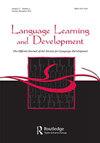Vocabulary Size Leads to Better Attunement to L2 Phonetic Differences: Clues from Russian Learners of English
IF 1.4
2区 文学
0 LANGUAGE & LINGUISTICS
引用次数: 10
Abstract
ABSTRACT Previous research has shown that an increased second language (L2) vocabulary size leads to better attunement to the cues required to distinguish L2 contrastive phones. This has been the central tenet of the vocabulary-tuning model (vocab) on the basis of evidence by Japanese learners of English in Australia. We aim to test the validity of the aforementioned hypothesis by extending the research for learners with a different first language (L1) background and learners who do not have naturalistic access to the L2 input (i.e., learn the L2 through a controlled foreign classroom setting). To this purpose, 28 Russian speakers, who were learning English in Russia at the time, participated in two psychoacoustic tests in which they were asked to assimilate L2 vowels to their L1 phonological system and discriminate vowel contrasts respectively. The participants were divided into two groups according to their vocabulary size in English; comprising the small vocabulary (SV) and the high vocabulary (HV) groups. The results showed that the HV group demonstrated similar assimilation scores to the SV group. However, the HV group was able to perceive within-category differences and more accurately discriminate specific pairs of English vowel contrasts in comparison to the SV group. The findings are partially consistent with the central hypothesis of the Perceptual Assimilation Model-L2 and the vocab model as the expansion of L2 vocabulary was linked with better attunement to phonetic differences in the L2. Another important finding is that a more developed vocabulary results in fine-tuning to L2 phonetic differences, even in a restricted L2 learning setting [work supported by the “RUDN University Program 5–100”].词汇量大导致二语语音差异的更好调和:来自俄语英语学习者的线索
先前的研究表明,第二语言词汇量的增加会导致更好地协调区分第二语言对比电话所需的线索。这是词汇调谐模型(vocab)的核心原则,其依据是在澳大利亚学习英语的日本人。我们的目标是通过将研究扩展到具有不同第一语言(L1)背景的学习者和没有自然接触L2输入的学习者(即通过受控的外国课堂环境学习L2)来检验上述假设的有效性。为此,28名当时在俄罗斯学习英语的俄罗斯人参加了两项心理声学测试,要求他们分别将L2元音吸收到L1语音系统中,并区分元音对比。参与者根据他们的英语词汇量分成两组;包括小词汇组(SV)和高词汇组(HV)。结果显示,HV组的同化得分与SV组相似。然而,与SV组相比,HV组能够感知类别内差异,并且更准确地区分特定的英语元音对比对。这一发现部分地与感知同化模型的中心假设——第二语言和词汇模型——相一致,即第二语言词汇的扩展与第二语言语音差异的更好调和有关。另一个重要的发现是,更发达的词汇会导致对二语语音差异的微调,即使在有限的二语学习环境中也是如此[由“RUDN大学计划5-100”支持的工作]。
本文章由计算机程序翻译,如有差异,请以英文原文为准。
求助全文
约1分钟内获得全文
求助全文

 求助内容:
求助内容: 应助结果提醒方式:
应助结果提醒方式:


